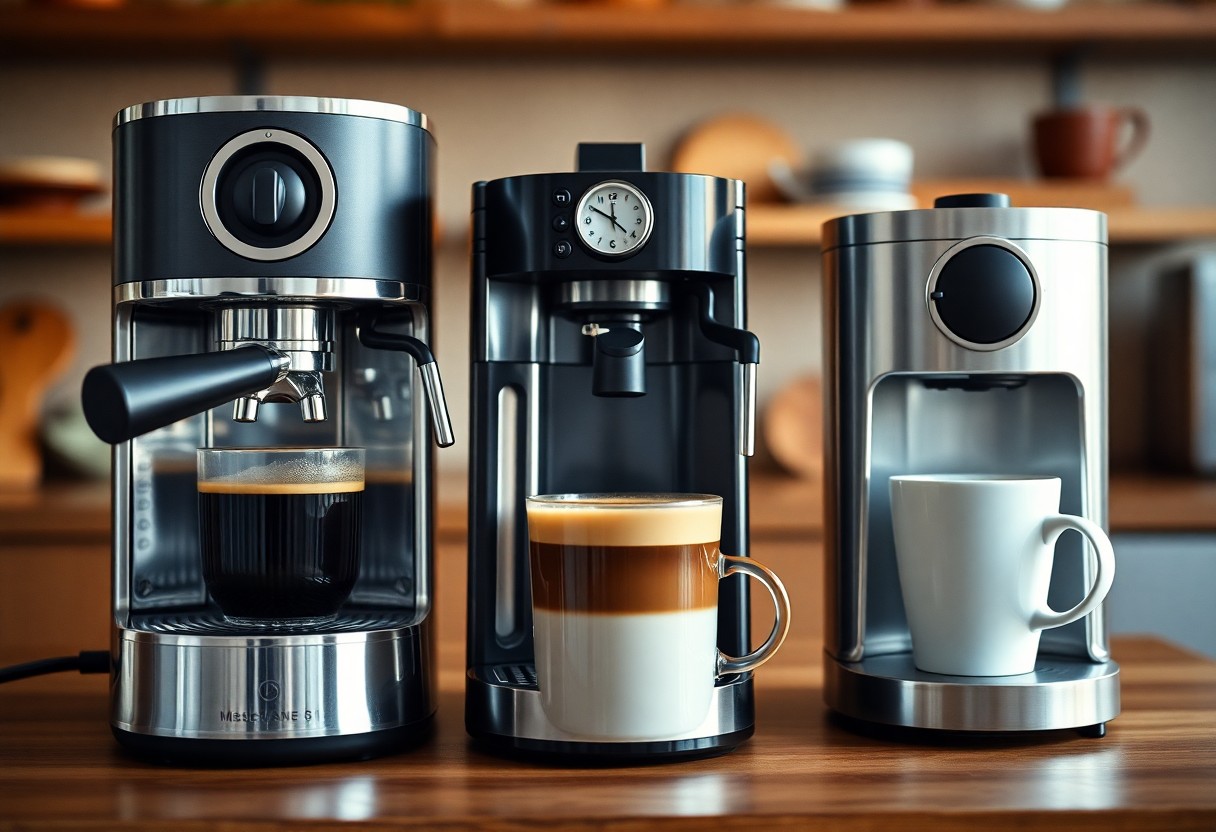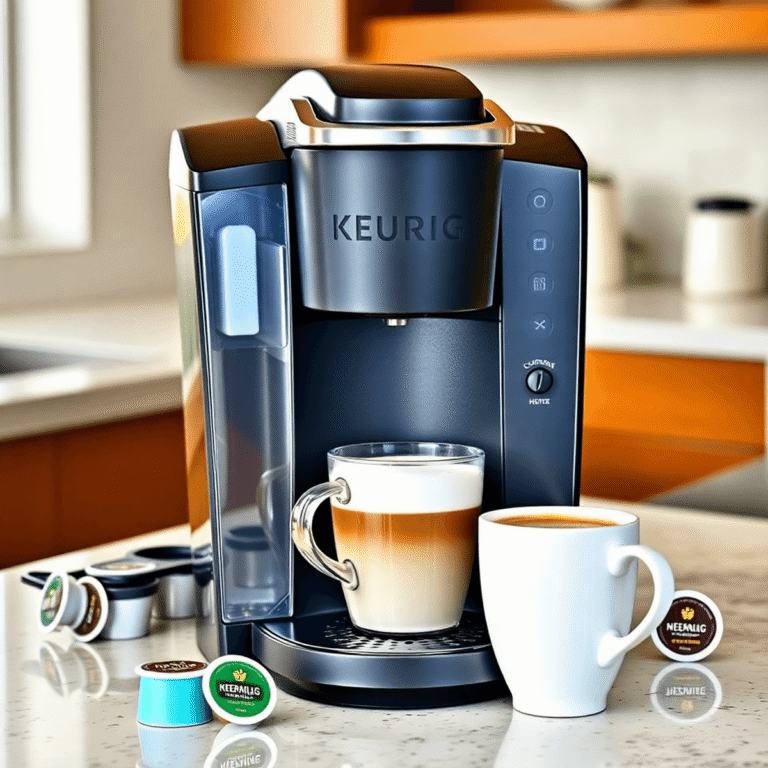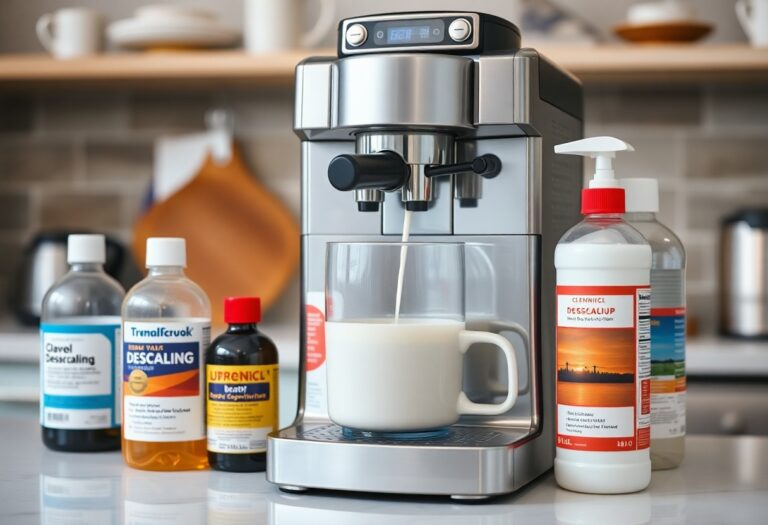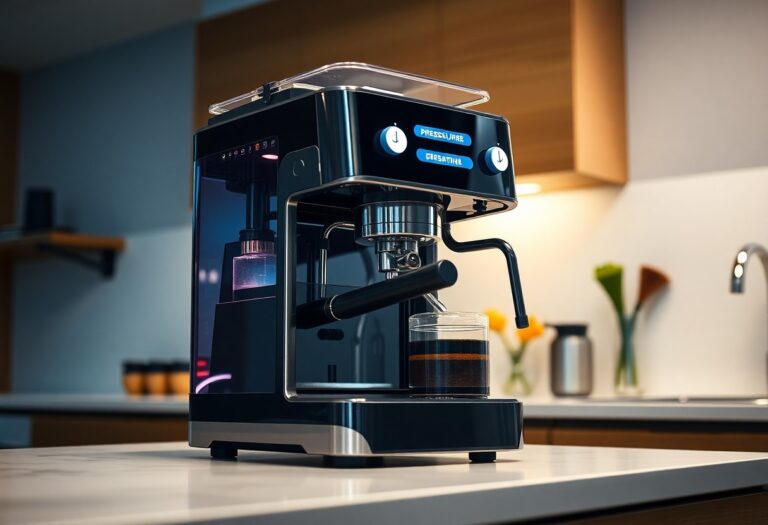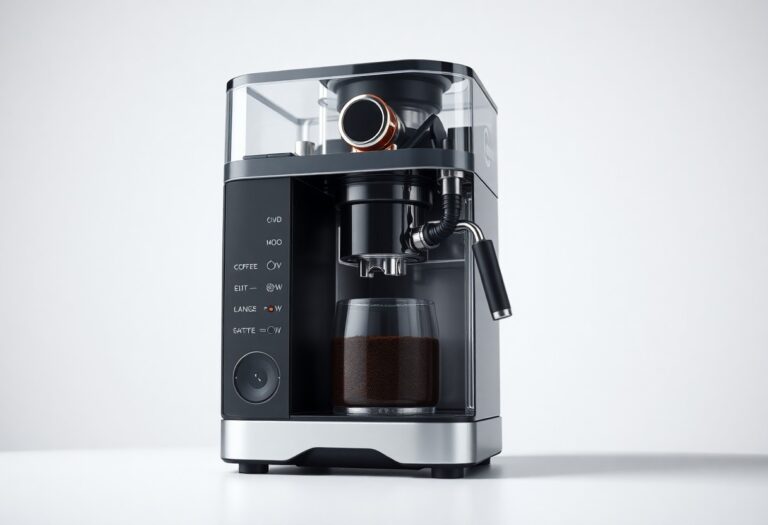What Machine Makes the Best Coffee – Quality Comparison
With a myriad of coffee machines available, choosing the right one can significantly impact the quality of your brew. You want a machine that not only meets your taste preferences but also enhances your coffee-making experience. In this guide, we will explore different types of coffee machines, their features, and how they can affect the flavor of your favorite coffee. For an in-depth look at espresso machines, check out The Best Espresso Machine. Make informed choices to elevate your coffee game!
You might be wondering which coffee machine will elevate your daily caffeine experience. In this blog post, we’ll explore various types of machines, from espresso makers to drip coffee makers, and how they compare in terms of flavor, convenience, and cost. Understanding the advantages and disadvantages of each will help you make an informed decision and ultimately brew a better cup of coffee. Dive in to find out which machine can transform your coffee routine into something extraordinary.
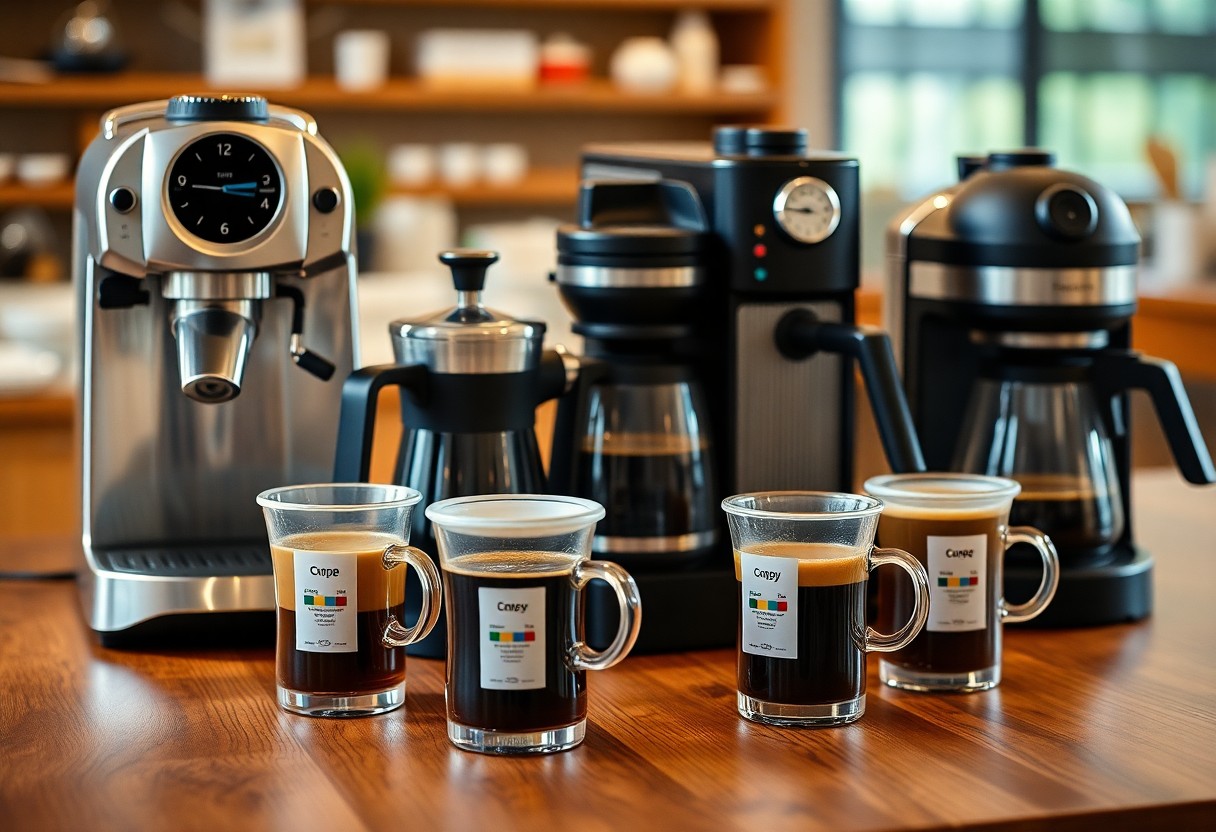
Key Takeaways:
- Different types of machines, such as drip coffee makers, espresso machines, and French presses, produce varying coffee flavors and strengths, appealing to diverse preferences.
- High-end espresso machines typically provide better temperature control and pressure consistency, resulting in superior extraction and flavor profiles.
- Single-serve coffee makers offer convenience and ease of use, but may sacrifice flavor complexity compared to traditional methods.
- Quality of beans and grind size play a significant role in the final taste, regardless of the machine used; investing in fresh, high-quality coffee is important.
- Personal taste ultimately determines the best coffee maker for an individual, making it important to consider brewing style and preferences when choosing a machine.
Key Takeaways:
- Different brewing methods impact flavor: Techniques such as espresso, drip, and French press each yield distinct flavor profiles and strengths in the coffee.
- Grind size matters: The texture of coffee grounds can significantly affect extraction and taste, with certain methods requiring specific grind sizes for optimal results.
- Water quality influences taste: The type and temperature of water used in brewing can alter the final flavor, making it imperative to use clean, filtered water.
- Machine features play a role: Advanced coffee machines may offer features like programmable settings, temperature control, and pressure adjustments, contributing to superior coffee quality.
- Freshness is key to flavor: Using freshly roasted beans and grinding them just before brewing can greatly enhance the taste and aroma of the coffee.
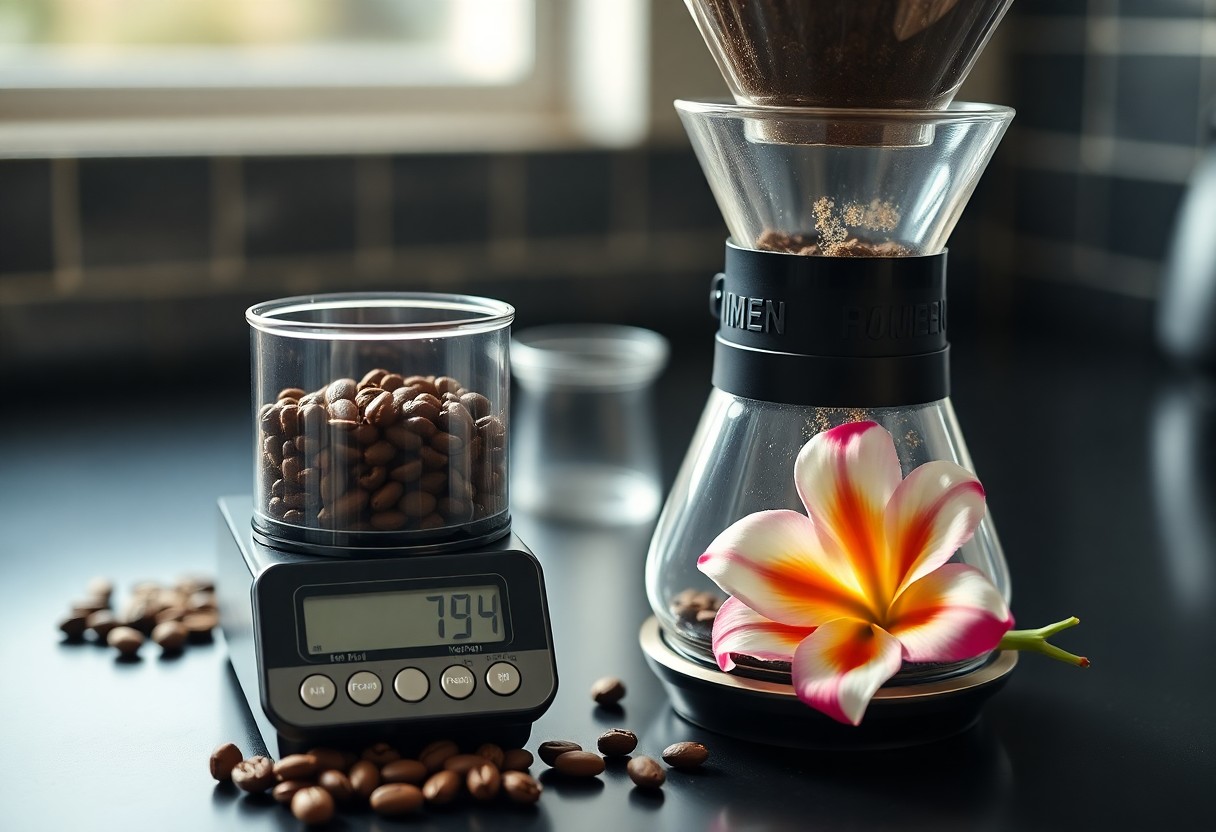
The Art and Science of Brewing: What Makes Great Coffee?
Mastering coffee brewing involves both artistry and scientific precision. From selecting high-quality beans to achieving the perfect extraction time, every detail affects the final cup. Consider flavor balance, acidity, and body to elevate your experience. The right machine, paired with your skill, allows you to explore various profiles, producing everything from bright and fruity brews to rich, full-bodied experiences. Your ability to adjust variables like water temperature and grind size directly influences the resulting flavor, making coffee brewing a captivating blend of creativity and technicality.
The Influence of Brew Methods on Flavor Profile
The choice of brewing method plays a pivotal role in shaping your coffee’s flavor profile. Pour-over techniques highlight intricate notes by allowing precise water flow, while espresso machines deliver a concentrated, bold experience. Methods like French press allow oils to contribute to a richer body, whereas cold brew emphasizes sweetness and lowers acidity. Experimenting with different brewing techniques ensures you discover the unique characteristics of each coffee type, thus tailoring your experience to your preferences.
Key Variables that Determine Coffee Quality
Several variables influence the overall quality of your coffee, playing a vital role in determining flavors and aromas. Factors such as the type and origin of the coffee bean, the grind size, water temperature, brew time, and even your water quality can dramatically alter the outcome. For example, brewing at a higher temperature can extract more oils and flavors, but excessive heat might lead to bitterness. Similarly, a coarser grind may result in under-extraction, producing a weak cup. Understanding and controlling these variables allows you to refine your coffee brewing for an optimal experience.
Examining these key variables reveals how interconnected they are in the quest for exceptional coffee. The origin of your beans greatly affects flavor; beans from Ethiopia, known for their acidity and fruitiness, differ immensely from those sourced in Brazil, with their chocolate and nutty undertones. Your grind size dictates the extraction rate; finer grinds tend to extract flavors faster, while coarser ones do so slower. Furthermore, water temperature can enhance sweetness or bitterness, depending on the brew method. Paying attention to these aspects not only enhances your knowledge but also empowers you to customize your brew to suit your taste profile.
The Science of Coffee Quality
The quality of your coffee is not just a matter of personal preference; it’s rooted in science. Understanding the chemistry behind brewing can elevate your coffee experience from good to exceptional. Factors such as the origin of the beans, processing methods, and even the roast profile can dramatically change the final cup. These elements interact with each other, leading to diverse flavor expressions that appeal to varying tastes.
Factors Influencing Flavor Profiles
Your coffee’s flavor is affected by several key aspects. Origin plays a significant role in determining acidity and body; processing methods can add fruitiness; and roast levels influence bitterness and sweetness. Different brewing techniques also extract flavors differently. Here’s a quick overview:
- Origin: Where the beans are grown impacts their flavor notes.
- Processing Methods: Wet, dry, or honey processing can enhance different flavor aspects.
- Roast Levels: Light, medium, or dark roasting alters flavor balance.
- Brewing Technique: French press, espresso, or pour-over offers unique flavor profiles.
This interplay results in the unique flavors you experience in each cup.
The Role of Brew Temperature and Time
Temperature and time are vital parameters in extracting the best flavors from your coffee. Brewing with water that’s too hot can lead to over-extraction, resulting in bitterness. Conversely, a brew that’s too cold will under-extract, yielding a sour taste. Achieving the right balance is key. Here’s a quick look at how these factors work:
Temperature and Time Parameters
| Temperature (°F) | Recommended Brew Time |
|---|---|
| 195-205 | 4-6 minutes |
| 190-200 | 2-4 minutes |
| 180-190 | 1-2 minutes |
Aiming for the optimal brew temperature paired with the right timing is necessary for flavor extraction. Water between 195°F to 205°F is preferred for most brewing methods, allowing for the perfect balance between acidity and sweetness, maximizing your coffee’s full potential.
Further Insights on Brew Temperature and Time
| Impact of Temperature | Impact of Brew Time |
|---|---|
| Higher temperatures extract more oils and flavors, but risk over-extraction. | Longer brew times allow for more flavor extraction, but can lead to bitterness if overdone. |
| Lower temperatures maintain acidity but may not fully extract flavor complexity. | Short brew times can yield lighter, brighter notes, beneficial for certain coffee types. |
Machines Under the Microscope: Comparing Popular Models
| Machine Type | Key Features |
|---|---|
| Espresso Machines | Handles pressure brewing; produces rich, concentrated shots. |
| Drip Coffee Makers | Convenient and automatic; varies in brew quality. |
| French Press | Manual method; emphasizes robust flavor extraction. |
Espresso Machines: The Pinnacle of Richness
Espresso machines give you the power to brew cafe-quality coffee at home, delivering a rich and concentrated shot that serves as the foundation for numerous coffee beverages. By forcing boiling water through finely-ground coffee at high pressure, these machines extract intense flavors, creating a velvety crema on top. Popular models often feature customizable settings for temperature and pressure, allowing you full control over your brew. If you’re aiming for barista-level coffee experiences, investing in a good espresso machine is important.
Drip Coffee Makers: Convenience vs. Complexity
Drip coffee makers excel in providing convenience, effortlessly brewing up to 12 cups with minimal effort. They offer various programmable features like auto-start and brew strength selection, catering to busy lifestyles. Yet, the quality can fluctuate based on the machine’s build and water temperature; lower-end models may produce coffee that lacks depth and flavor. Investing more in a well-reviewed drip coffee maker can significantly enhance your daily brew, giving you a balance of simplicity and quality.
While drip coffee makers offer remarkable convenience, they often sacrifice some flavor complexity inherent to other brewing methods. Many users appreciate the ability to wake up to freshly brewed coffee, while the automatic process minimizes hands-on involvement. However, the quality of the grind and type of coffee beans plays a pivotal role in the end product. Upgraded models might incorporate technology like thermal carafes, which help maintain temperature without compromising flavor. Therefore, for those who want easy access to coffee without a steep learning curve, a drip coffee maker remains a popular choice.
French Press: A Case for Manual Elegance
The French press allows you to engage in a tactile brewing experience, emphasizing the beauty of manual coffee-making. This method requires coarsely ground coffee and hot water, steeped together for several minutes before the grounds are separated from the liquid through a plunger mechanism. This process allows for full immersion, extracting out rich flavors and oils that contribute to a robust taste profile. Moreover, the ability to adjust steeping times gives you direct control over the strength of your coffee.
The French press champions a slower, more thoughtful brewing approach, appealing to coffee enthusiasts who relish the process. You’re not just brewing coffee but crafting a personal experience. The simplicity of the device offers charm, but it also requires attention to detail regarding grind size and steeping time, which can greatly impact the final cup. Many enthusiasts enjoy exploring different coffee beans, understanding how varying brewing times influence flavors, making the French press not just a tool but a conduit for coffee exploration.
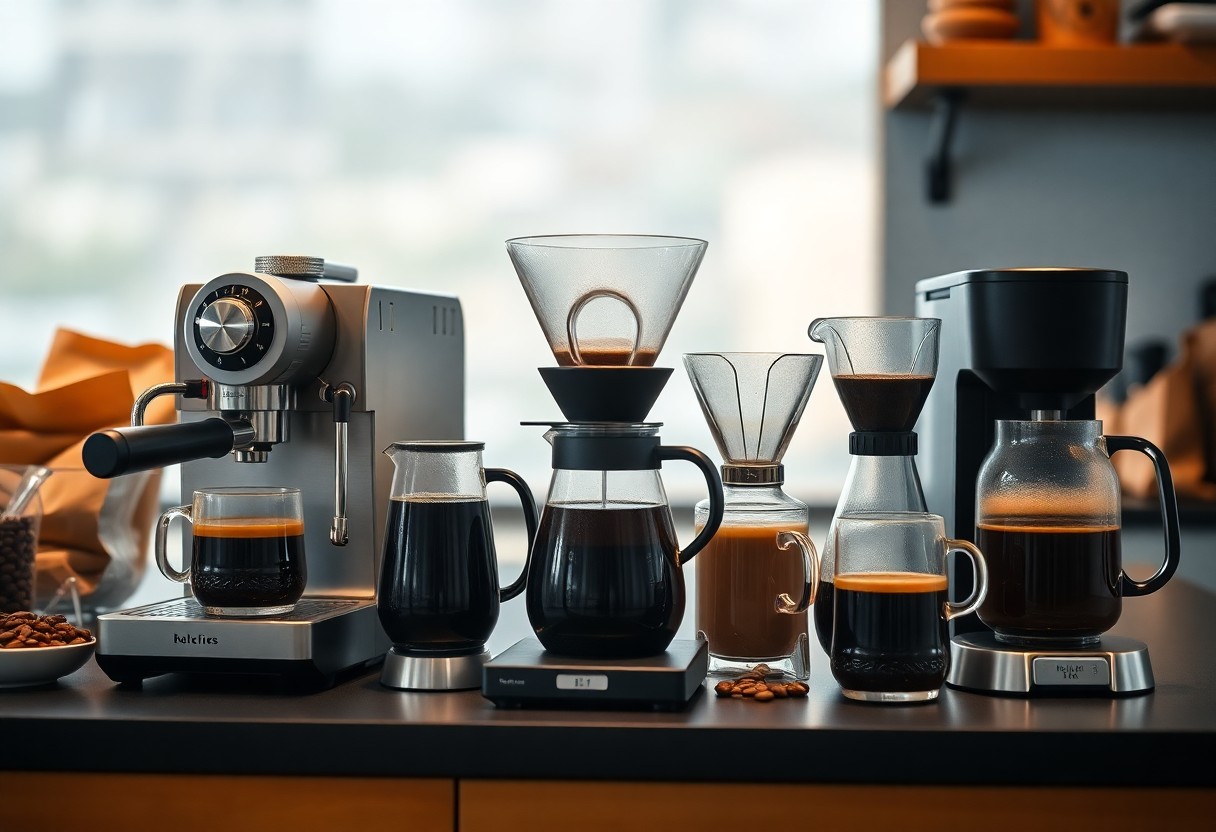
Breaking Down Brewing Methods
Exploring various brewing methods reveals unique facets of coffee-making, each with distinct characteristics that influence flavor and aroma. Understanding these methods enables you to elevate your coffee experience, whether you prefer speed, precision, or rich, full-bodied satisfaction. Highlighted below are some of the most popular methods that redefine coffee brewing.
Espresso Machines: Precision and Pressure
Espresso machines excel at delivering concentrated coffee through high pressure and finely ground beans, showcasing the full spectrum of flavors. With optimal pressure, these machines extract important oils and flavors in mere seconds, resulting in a rich and creamy brew. Mastering the art of espresso requires not only a good machine but also careful calibration of water temperature and grind size.
Pour-Over Systems: The Art of Manual Control
Pour-over systems emphasize your control over brewing time and water flow, resulting in a clean and delicate cup of coffee. You manipulate the variables to coax out different flavor notes, achieving a variety of tastes from the same beans. This method requires practice and patience to perfect the water-to-coffee ratio and pouring technique.
Delving deeper into pour-over methods, you’ll find that subtle adjustments can have significant impacts on flavor. For instance, using a gooseneck kettle allows for more precise pouring, enhancing your control over extraction. The grind size, water temperature, and infusion time can all be tailored to highlight specific profiles of the coffee you use. As you perfect your technique, you can even explore different pouring patterns, elevating your brewing to an art form.
French Press: Full-Bodied Flavor Richness
The French press stands out for its ability to produce a rich and full-bodied coffee through immersion brewing. Coffee grounds steep directly in hot water, allowing for maximum extraction of oils and flavors, resulting in a velvety texture. It’s an excellent option for those who appreciate robust flavors without the need for a complex brewing process.
Using a French press gives you an unparalleled intimacy with your coffee, as you can directly influence brew time and water temperature for an optimal extraction. Typically, a four-minute steep yields a well-rounded flavor, but experimenting with different times can unlock a world of taste possibilities. The unique mesh filter lets important oils pass into your cup, contributing to the pronounced richness that aficionados love. Embracing this method can yield a coffee experience that is both simple and surprisingly complex.
User Experience: Ease of Use and Cleanup
A smooth user experience can significantly enhance your coffee-making journey. Machines that prioritize simplicity offer intuitive interfaces, ensuring even beginners can brew excellent coffee without hassle. Cleanup is another crucial factor; easy-to-disassemble parts and dishwasher-safe components streamline the maintenance process. Investing in a machine that values user-friendliness can save you time and frustration in the long run.
Accessibility for Beginners vs. Advanced Users
Finding a coffee machine that caters to both novices and seasoned baristas is vital for enhancing your brewing experience. An accessible design should include features that are straightforward enough for beginners while also offering advanced functions that satisfy more experienced users.
- Simplified controls for ease of use
- Variety of brewing options to cater to different skill levels
- Support resources like instructional videos or manuals
- Quick cleanup process through detachable parts
- Customizable settings for advanced brewing techniques
| Machine Type | Accessibility Features |
|---|---|
| Single-Serve | Easy to operate; minimal cleanup required |
| Espresso Machine | Requires some skill; offers advanced options |
| French Press | Simple process; requires manual effort |
| Pour-Over | Engaging and hands-on; technique-dependent |
Maintenance and Longevity of Machines
Optimizing the lifespan of your coffee machine hinges on proper maintenance. Regularly descaling your machine and cleaning removable parts can prevent buildup and ensure that every cup delivers superior flavor. Investing in machines made with durable materials can also extend their longevity, making them a smart choice in the long run.
Long-term performance is often dictated by your maintenance habits. For instance, machines that require regular descaling every 2-3 months ensure that you avoid mineral buildup, which can compromise brewing efficiency and taste. Following the manufacturer’s guidelines is key; some brands may have specific cleaning solutions or techniques that enhance your machine’s lifespan. Regularly replacing water filters and checking seals can also prevent costly repairs, making your investment worthwhile for years to come.
Comparing Machine Technologies
| Machine Type | Advantages |
|---|---|
| Espresso Machines | Produce concentrated shots with rich crema, perfect for specialty drinks. |
| Drip Coffee Makers | Convenient for brewing multiple cups quickly and consistently. |
| French Press | Offers full-bodied flavor and imperative oils from coffee grounds. |
| Pour-Over | Allows greater control over brewing parameters for optimal taste. |
Grind Consistency and Its Impact on Taste
Grind consistency plays a vital role in extracting flavor from your coffee. Unevenly ground coffee results in a blend of over-extraction and under-extraction, leading to a muddled taste. Machines with high-quality burr grinders provide a uniform grind size, ensuring that each coffee ground releases its imperative oils consistently. This means your cup will taste richer, with distinct flavor notes shining through rather than a flat or bitter profile.
Automatic vs. Manual: The Taste Debate
Choosing between automatic and manual coffee machines can significantly affect the end flavor of your brew. Automatic machines often simplify the process, delivering convenience but may compromise on personal preferences. Manual brewing techniques grant you full control over variables like water temperature and extraction time, leading to a more tailored and nuanced flavor. The debate hinges on your coffee priorities: if precision is paramount for exquisite taste, manual methods shine; otherwise, the efficiency of automatic devices suits busy lifestyles.
Exploring the automatic versus manual brewing debate highlights key differences that affect taste. Automatic machines excel in delivering consistent results with minimal effort, making them ideal for those who prioritize speed and convenience. However, enthusiasts argue that the tactile engagement of manual brewing leads to a deeper understanding and connection with the coffee-making process. You might find that adjusting parameters with a pour-over or Chemex, for example, can unlock unique flavor profiles unattainable with automation. Ultimately, your choice should align with whether you value precision or convenience in your daily coffee ritual.
The Price vs. Quality Debate: Getting Your Money’s Worth
The relationship between price and quality in coffee machines can feel complex. While it may be tempting to buy the cheapest option available, you often get what you pay for. Investing in a machine with a higher price tag usually translates to better craftsmanship, enhanced brewing technology, and a superior overall experience. Choosing wisely can lead to long-term savings on beans and maintenance, ultimately making your purchase worthwhile.
Budget-Friendly Machines That Don’t Compromise
Some budget-friendly coffee machines deliver respectable performance without straining your wallet. Brands like Mr. Coffee and Bonavita offer drip coffee makers that consistently produce quality brews. These machines incorporate features such as temperature control and simple interfaces, ensuring you don’t have to sacrifice the taste of your morning cup, even when on a tight budget.
Investing in High-End Coffee Makers: Is It Worth It?
Investing in high-end coffee makers can yield a significant payoff in terms of flavor and consistency. Although their price tags might be daunting, premium machines from brands like Breville or Rancilio feature advanced technology that allows for precise temperature control and pressure regulation, resulting in aromatic and flavorful coffee. Lasting durability and often customizable options can also enhance your overall brewing experience, making it a worthwhile endeavor for serious coffee lovers.
High-end coffee makers often come equipped with features that provide an unmatched level of customization, from grind size settings to brew time adjustments. Consider models like the Technivorm Cup-One, which brews single-serve coffee with precision, or the Jura E8, which offers one-touch specialty drinks. These machines typically have superior build quality, ensuring longevity, and many come with warranties or service plans. For those who truly savor coffee, this initial investment can pay off over time, delivering rich flavors and intricate aromas that often surpass what lower-end machines can achieve.
Cost vs. Quality: A Financial Perspective
Investing in a coffee machine often boils down to balancing cost and quality. High-end machines excel in performance and durability, providing consistent brews that are hard to replicate at lower price points. However, budget-friendly options can still yield satisfying results if you know where to look. Evaluating your coffee preferences and how frequently you brew can help determine what fits your budget while meeting your quality standards. For a comprehensive look at top contenders, check out The 8 Best Coffee and Espresso Machine Combos, Tested ….
Budget-Friendly Machines That Impress
Many budget-friendly machines outperform expectations, offering solid features without breaking the bank. Models like the Mr. Coffee Cafe Barista provide decent espresso and latte capabilities at a fraction of the price of luxury machines. With user-friendly controls and easy cleanup, these options make great everyday brewers for those new to coffee making.
Luxury Machines That Justify Their Price Tag
Luxury coffee machines often come with premium features that enhance the brewing experience, providing you with unmatched quality. Brands like Breville and De’Longhi incorporate advanced technology like PID temperature control and built-in grinders, ensuring every cup is perfectly crafted. These machines are designed for serious coffee aficionados who appreciate the subtleties in flavor and aroma, often leading to substantial savings over frequent café visits. Investing in one of these high-end machines transforms your kitchen into a barista’s paradise, delivering café-quality brews at home.
User Experience: Ease of Use and Maintenance
User experience significantly influences your coffee brewing journey. A machine that is user-friendly typically enhances both the satisfaction of making coffee and the overall enjoyment of the final product. Features such as intuitive controls, programmable settings, and easy access to the components for maintenance not only save time but also contribute to the longevity of the machine. By staying focused on ease of use, it becomes easier to create café-quality coffee at home without unnecessary hassle.
The Learning Curve: Time Investment and Skill
Some coffee machines require a steep learning curve, demanding your time and skill to master the brewing process. For example, manual espresso machines offer greater control, yet involve the risk of error without practice. On the other hand, single-serve pod machines deliver consistency right out of the box, making them ideal for those with limited experience or time to invest. Your proficiency with each machine type can greatly dictate what you find enjoyable about making coffee.
Cleaning and Longevity: A Practical Consideration
Maintaining your coffee machine is vital for both hygiene and flavor. Easy-to-clean machines often encourage regular upkeep, which can significantly enhance the life expectancy of your unit. Machines with removable parts, such as grind chambers and water reservoirs, allow you to quickly access and clean, whereas non-removable components may require more effort to maintain.
Regular cleaning not only eliminates old coffee oils and residues that can taint your brew but also ensures optimal functionality. Machines with descaling features can extend the lifespan of components by preventing mineral buildup, while those constructed from durable materials resist wear over time. For instance, stainless steel bodies typically endure better than plastic ones. You should always prioritize the ease of maintaining your coffee machine, as this often translates into a better tasting cup and a more enjoyable brewing experience overall.
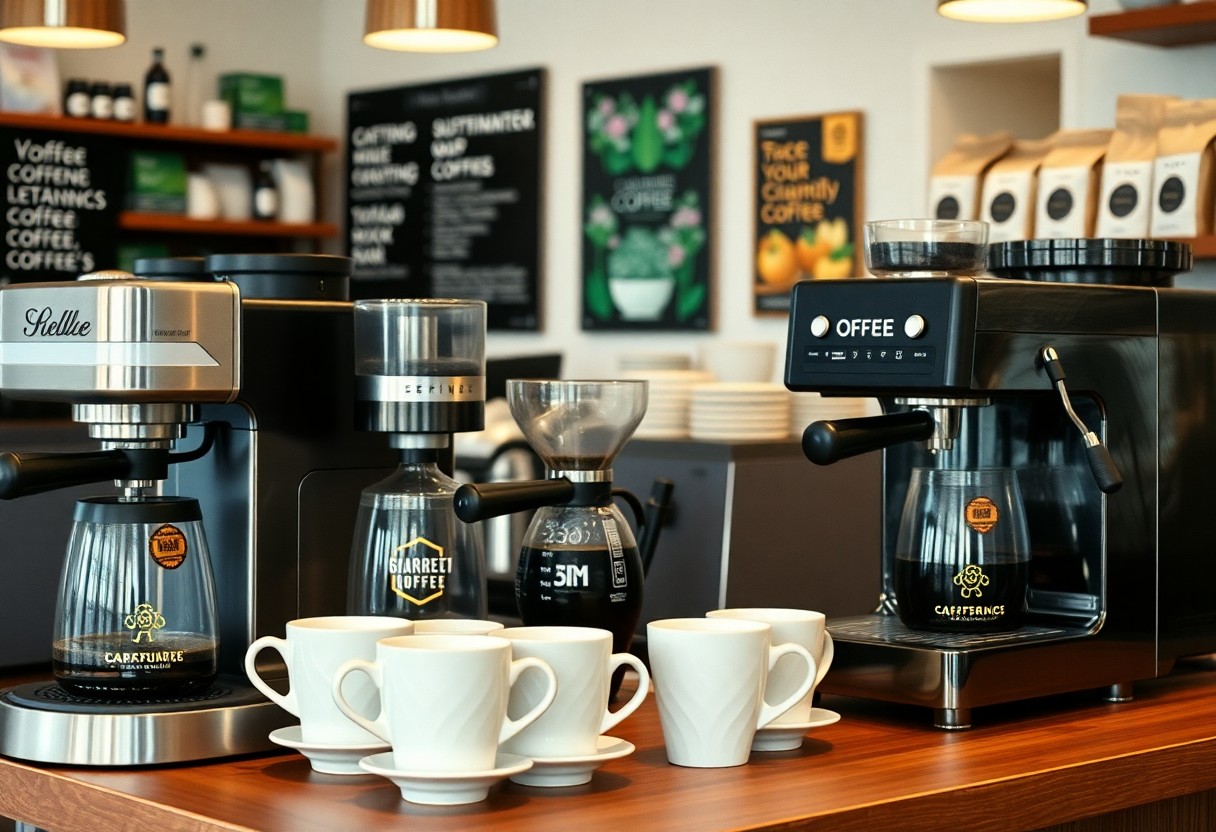
Beyond Your Cup: Environmental Impact and Sustainability
Every cup of coffee you sip has implications far beyond taste; it influences the environment and ecosystem. The coffee industry is notorious for issues like deforestation, water wastage, and pesticide use. Emphasizing sustainable practices can significantly reduce your ecological footprint while enjoying your daily brew. Selecting machines that promote efficiency and minimal waste can also contribute positively to environmental stewardship, ensuring that your love for coffee doesn’t come at a cost to the planet.
Eco-Friendly Coffee Machines and Practices
Eco-friendly coffee machines offer innovative solutions to reduce your environmental impact. Look for models that consume less energy, use recyclable materials, and incorporate water-saving technology. Some machines even have features designed to optimize brewing time and temperature, which can enhance flavor while minimizing electricity usage. Coupled with your choice of ethically sourced beans, these practices create a more sustainable coffee routine that you can feel good about every morning.
Evaluating Coffee Sources: Ethical Considerations
When sourcing your coffee, ethical considerations are paramount. Supporting producers who prioritize fair labor practices, sustainable farming, and environmental care can help cultivate healthier ecosystems and communities. Seek out certifications like Fair Trade or Rainforest Alliance, which represent a commitment to ethical sourcing, ensuring that your coffee habit promotes social welfare and ecological integrity.
Ethical sourcing in coffee extends beyond simply choosing certified brands; it involves understanding the full supply chain from farm to cup. By purchasing beans from farmers who receive fair compensation, you contribute to better living conditions and sustainable growing practices. In fact, Fair Trade producers earn up to 25% more than those reliant on conventional trade due to direct relationships established with buyers. Supporting these practices helps ensure that your coffee consumption supports both people and the planet, creating a positive cycle of benefit that reaches every individual involved in the coffee journey. You can make a difference with each brew by consciously choosing ethically sourced coffee.
To wrap up
Ultimately, selecting the best coffee machine for your needs requires weighing factors such as brewing method, ease of use, and your particular taste preferences. Whether you prefer the convenience of a drip machine, the craftsmanship of a manual espresso maker, or the speed of a pod system, understanding these elements will guide you to the right choice. By focusing on quality and your specific requirements, you can elevate your coffee experience and enjoy each cup to its fullest potential.
To wrap up
Hence, when selecting the machine that makes the best coffee for your needs, you should carefully consider the quality and features that align with your coffee preferences. From espresso machines to drip coffee makers, each type offers distinct advantages. For in-depth comparisons and insights, you can explore the Best Espresso Machines in 2025: From Budget to Barista- …. Ultimately, investing in the right coffee machine can elevate your daily brew and enhance your coffee experience.
FAQ
Q: What types of coffee machines are available for making high-quality coffee?
A: There are various types of coffee machines available that can brew high-quality coffee, including espresso machines, drip coffee makers, French presses, pour-over devices, and single-serve machines. Espresso machines are favored for their ability to produce rich, concentrated coffee, while pour-over and French press methods allow for greater control over brewing variables, enhancing flavor extraction. Drip coffee makers are convenient for brewing larger quantities, and single-serve machines offer ease of use and consistent results.
Q: How do espresso machines compare to drip coffee makers in terms of quality?
A: Espresso machines typically produce higher-quality coffee compared to traditional drip coffee makers due to their ability to generate the pressure required to extract flavors and oils from the coffee grounds. This results in a richer, more intense flavor profile that is characteristic of espresso. However, drip coffee makers can brew excellent coffee as well, especially when using quality beans and proper brewing techniques. The choice depends on personal preferences regarding coffee strength and preparation method.
Q: What features should I consider when selecting a coffee machine for quality brewing?
A: When choosing a coffee machine for quality brewing, consider features such as temperature control, brew time, grind settings (if applicable), and the material of the machine. Temperature control ensures that water is at the optimal brewing temperature, significantly impacting flavor. A machine with programmable settings can also enhance convenience, while equipment made of high-quality materials tends to produce better results and longer durability.
Q: Is there a difference in coffee quality between manual and automatic machines?
A: Yes, there is often a noticeable difference in quality between manual and automatic machines. Manual machines, like pour-over and French presses, allow for greater control over brewing variables such as grind size, water temperature, and extraction time, resulting in a more personalized and potentially superior cup of coffee. Automatic machines offer convenience and consistency but may not allow for the same level of customization that can enhance flavor. The best choice depends on whether you prioritize convenience or seek a more hands-on brewing experience.
Q: How does the type of coffee beans affect the quality produced by different machines?
A: The quality of coffee produced is significantly influenced by the type of coffee beans used, regardless of the machine. Freshly roasted, high-quality beans generally yield the best flavor profiles, while older or lower-grade beans may result in subpar coffee. Different brewing methods also interact uniquely with various bean types and roast levels. For example, light roasts may shine in pour-over methods, whereas darker roasts may work better in espresso machines. Selecting the right beans for your chosen brewing method can dramatically impact the quality of your coffee.

